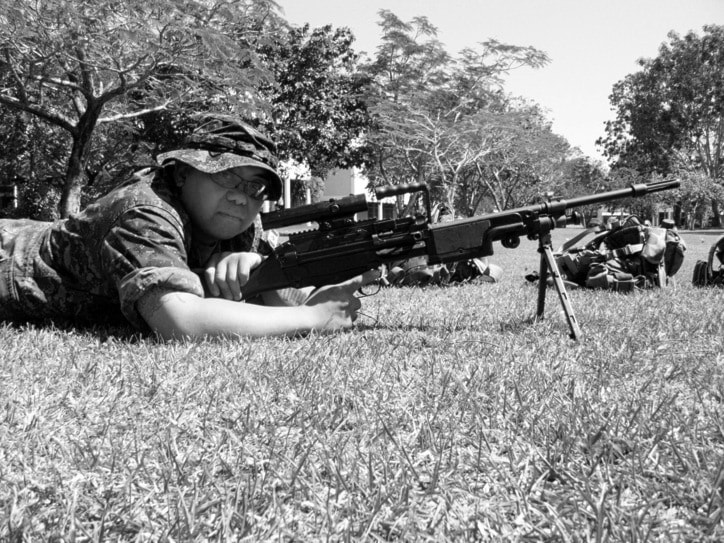PORT HARDY — Glen Catarata did manage to take in a few of the sights on a recent trip to Australia. But the sergeant and patrol commander for Port Hardy’s Canadian Ranger detachment had plenty of reminders that he was part of a military operation.
“There was a lot of hurry up and wait,” said Catarata, a 20-year veteran who was invited as part of a select group of Rangers to train with the North-West Mobile Force (NORFORCE) infantry regiment in and around Darwin in July and August. “We pretty much did it all. Planes, trains and automobiles.”
Not to mention an eight-hour boat trip in a troop transport craft which took the 15-member Rangers delegation from the main NORFORCE command.
“A lot of the stuff I learned there I’ll bring back to my own patrol — things we can be using.”
Of course, Catarata experienced things on this trip that are unlikely to crop up in a Canadian deployment. Like avoiding crocodiles, snakes, spiders and even a poisonous tree on two-day bivouac in the bush. Or using dried kangaroo and wallaby dung as fire starter. Or dealing with 30-35C temperatures, even in the middle of the Australian winter.
“There were a lot of creepy-crawlies,” said Catarata, who rolled out his light field blanket inside a bug screen each night, whether in the field or in the remote and spare barracks of the Kangaroo Flats training camp.
This summer’s exchange trip by the 15-member Canadian Rangers team will be followed by a visit to Canada by a NORFORCE delegation, likely in the next year to 18 months. The exchange program was initiated by a NORFORCE commander who read about the Canadian Rangers and who was struck by it similarity to his own command, which is part of the Australian Army Reserve tasked with reconnaissance, observation and collection of military intelligence in Australia’s northern territories.
Catarata’s adventure began with two days of preparatory meeting and pre-training in Victoria with six Rangers from B.C., five from Alberta and four from Manitoba. After a bus-and-ferry trip to Vancouver International Airport, the group took a 15-hour flight to Sydney, spent a day to shrug off the jet lag, then flew another five hours to Darwin in the Northern Territories to begin the training.
The Rangers were versed in an introductory safety course, covering first aid, hydration and avoidance/treatment of snake and spider bites. They trained with the Australian Army’s F88 Austeyr assault rifle, spending three days on simply breaking down and re-assembling the weapon before they were allowed even to use it on a computer simulation “firing range”.
“They wanted us to be perfect before we ever got to the range,” Catarata said.
The team also did capsizing drills with a Zodiac inflatable boat, and Catarata said perhaps the greatest challenge he faced was the swimming test that every Ranger had to pass before taking part in the drill.
“It was a 100-metre swim in full combat (gear), except for boots,” he said. “At the end of it we had to tread water for two minutes. That was probably the hardest part for me the whole time.”
Things got interesting when the group shifted to the remote Gove peninsula, in the Nhulunbuy region. At Gulkula, they were treated to an audience at Garma Festival, Australia’s major indigenous cultural exchange event, where they saw tribal dances and music.
“When they found out we were from Canada, they were especially keen to meet any First Nations in the Rangers,” said Catarata. Only one member of the team, a soldier from Manitoba, was aboriginal. “He was real popular.”
Catarata and his mates then joined NORFORCE recruits for field training, which features many techniques imparted to NORFORCE by aboriginals over the years. These included building spears, collecting water from trees or bare earth by condensation, and starting fires with bow and drill.
They also learned to navigate by sun and stars, which took some adjustment considering the different constellations of the Southern Hemisphere.
“Once you figured out the Southern Cross, it wasn’t too hard,” Catarata said.
Due to the limited time in the field, the group was not required to catch its own “Bush Tucker” — food caught in the wild. But the Rangers still got a taste of Australia’s wild game.
“They came and dumped out a big bag of meat,” Catarata said. “Croc, water buffalo and kangaroo or wallaby, I’m not sure which. They said, ‘Go ahead and eat it.’ It was pretty good.”
Two days in Sydney to “decompress” followed. About the only thing the Rangers did not do during their stay was drive on its left-hand-side roads.
“They wouldn’t even let us rent a car,” he said.
